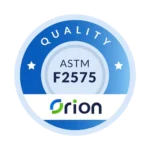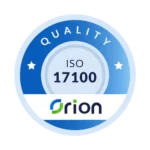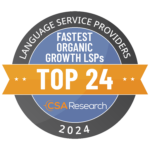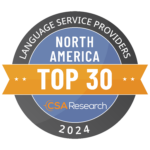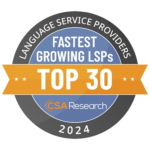- Home
- /
- Blog
- /
- Multilingual Events
- /
- How to Plan and...
How to Plan and Execute Successful Multilingual Events

Multilingual events are the future of event planning! With globalization on the rise, businesses and individuals want to connect with people from diverse backgrounds and cultures.
Event professionals know multilingual events are essential in today’s global business landscape. But, let’s face it, organizing a multilingual event can be daunting.
From language barriers to cultural differences, event planners face unique challenges in creating an inclusive and engaging experience for all attendees. However, don’t let that intimidate you!
This blog post will help equip you with the tools and strategies to create impactful multilingual events that will leave a lasting impression. So, let’s elevate your event planning game and help you break down language barriers like a pro!
Related: Cost-Effective Tips for Planning Multilingual Events
Step One: Define Your Multilingual Event Objectives
The first step is to define your goals and objectives. Here are some quick expert tips:
1. Set specific goals: Think about what you want to achieve and clarify it. Do you want to increase collaboration, expand your network, or foster international partnerships? Clearly define the specific and realistic outcomes you want to achieve.
2. Align with organizational objectives: Your event should align with your organization’s broader goals. By doing so, you can demonstrate the value of your event and justify the investment in a multilingual event.
3. Develop a clear value proposition: What are the benefits of attending your event? Is it learning opportunities, networking, or exposure to new ideas? Articulate the value proposition of your event to attract and engage attendees.
4. Prioritize objectives: With multiple goals, it’s important to prioritize them in order of importance. It helps focus your planning efforts and allocate resources effectively. A list of “must-haves” and “can’t do withouts” will be very helpful in helping you allocate all resources, including linguistic ones.
Step Two: Know Your Target Audience
You must understand your guests to create an inclusive and engaging multilingual event. Follow these guidelines:
1. Conduct audience research: Gather data on your attendees through registration forms, social media profiles, and other sources.
2. Create attendee personas: Develop profiles representing different segments of your audience to tailor event content, activities, and communication strategies.
3. Identify language preferences: Determine the primary and secondary languages your attendees speak to plan appropriate translation and interpretation services.
For example, A 22-year-old woman from Beijing may speak Mandarin, the official language of China and the most widely spoken, whereas a 70-year-old man from Shanghai may speak Shanghainese, a dialect of Wu Chinese. They may also have a completely different linguistic preference that is not related to their place of origin or current residence.
4. Adapt event format: Consider your audience’s cultural and linguistic backgrounds when designing the layout, such as balancing formal presentations and interactive activities.
Bottom-line: get to know your target audience to make your multilingual event successful!
Step Three: Cater to Language Needs
To make sure all attendees can participate and benefit from your multilingual event, keep the following tips in mind:
1. List Languages: Make a comprehensive list of the languages spoken by your attendees, presenters, and staff, including any regional dialects or variations.
For instance, in the case of Spanish-speaking attendees, consider whether your attendees are from Spain or Latin America, as there may be differences in vocabulary and structure. Even within Latin America, a menu or lunch options list will look completely different depending on the country of origin of your audience.
2. Plan for Language Services: Based on the identified languages, plan for the necessary translation and interpretation services that may be needed, including written materials, presentations, and real-time interpretation.
3. Allocate Resources: Determine the budget and personnel required to support multilingual communication, including hiring professional interpreters and translators and acquiring the necessary equipment.
4. Inform Attendees: Ensure attendees know about the available language services, such as simultaneous interpretation, translated materials, or designated language support staff. It will help them feel more comfortable and engaged during the event.
By taking these actions, you create a more inclusive and effective multilingual event.
Step Four: Deliver Translation and Interpretation Services
Language should never be a barrier to the success of your event. To ensure all attendees can understand and engage with your content, here are some key strategies to implement:
1. Engage a Professional Language Service Provider (LSP): Don’t rely on Google Translate or the language skills of a well-meaning volunteer. Hire an experienced LSP to provide top-quality interpretation and translation services. With a reputable provider, you can guarantee that your attendees will receive accurate and reliable language support.
2. Embrace Technology: Technology is your ally in language services. Utilize real-interpreting equipment such as headsets and other tools to enhance translation and interpretation services. Many LSPs even offer rental interpreting equipment, saving you time and additional costs. Make sure to plan and test all services and equipment before the event to avoid any mishaps.
3. Event App: Develop a dedicated event app that offers real-time updates, notifications, and information in multiple languages. The app can include features like maps, schedules, and speaker bios, ensuring attendees can access essential information in their preferred language.
By providing professional language support, you can ensure that all attendees can fully participate in your event and get the most out of their experience.
Step Five: Be Culturally Sensitive
It’s essential to consider cultural differences to make your event inclusive and enjoyable for everyone. Consider the following elements:
1. Dress Code: Communicate your dress code expectations to attendees, as different cultures may have varying perspectives on appropriate attire. Be mindful of the specific cultural considerations and provide clear guidance for what is and isn’t appropriate.
2. Seating Arrangements: Respect cultural norms and provide inclusive seating arrangements that cater to different cultural practices. Consider separate seating areas or flexible arrangements to ensure all attendees feel comfortable.
3. Food Preferences: Cater to various dietary restrictions and preferences and clearly label food options. This way, your guests will know what they’re eating and avoid eating anything against their cultural or religious values. Be aware of common allergies and sensitivities and provide alternative options where necessary.
Step Six: Foster Effective Communication
Effective communication is the cornerstone of a successful multilingual event. Consider these creative tactics to enhance communication and engagement among attendees:
1. Get the conversation flowing: Develop inclusive icebreakers that encourage attendees to interact and engage with one another. For example, play a game that requires teamwork and communication.
2. Make it visual: Utilize visual aids such as infographics, diagrams, and images to supplement verbal communication. These can help to convey complex concepts and ideas more efficiently and make them accessible to a broader audience.
3. Keep everyone in the loop: Offer simultaneous interpretation services during presentations and panel discussions to ensure all attendees can follow along and participate in real-time. It helps keep everyone engaged and connected throughout the event.
4. Encourage participation: Create an environment that encourages questions from all attendees, regardless of their language of preference. Provide a designated time for Q&A and ensure interpreters are available for those needing assistance. It can foster a sense of inclusivity and encourage attendees to engage with one another.
Step Seven: Optimize Your On-site Interpreters For Multilingual Events
On-site interpreters are the backbone of multilingual events. To maximize their value, keep the following in mind:
1. Understand interpreter ratios: As a general rule of thumb, one interpreter can handle up to 30 minutes of interpreting before requiring a break. Consider the length of your sessions and the number of languages to determine how many interpreters you’ll need on-site.
2. Provide background information: Furnish interpreters with background information about the event and its participants. Knowing the event’s purpose and the speakers’ topics and styles helps interpreters prepare for their assignments.
3. Maintain a line of communication: Establish a communication system to relay any last-minute changes to interpreters or receive feedback from them.
Step Eight: Supply Multilingual Materials and Signage
Providing multilingual materials and signage is essential to ensure all attendees have equal access to information. Consider the following tactics:
1. Collaborate with your LSP: Work closely with your Language Service Provider to translate all necessary materials, including programs, brochures, and handouts, into the languages your attendees speak. Doing so ensures everyone can engage with the content in their preferred language.
2. Design with inclusivity in mind: When designing signage, use clear and accurate language, universal symbols, and an accessible font size. Ensure all signs are visible and well-lit, and use consistent design elements to avoid confusion.
3. Optimize digital content: Make sure your event website, registration forms, and email communications are available in multiple languages. It will help attendees from different linguistic backgrounds quickly access and understand event-related information.
4. Encourage speaker involvement: Encourage your speakers to provide multilingual versions of their presentation slides or include subtitles in other languages. It will ensure all attendees can follow along and understand the content, regardless of their language proficiency.
CSA Research, formerly known as Common Sense Advisory, has done extensive studies over the years showing that language significantly impacts consumer behavior. They found that consumers prefer to buy products and services in their native language and are more likely to trust the information presented in their language.
So providing multilingual materials and signage ensures inclusivity and benefits your event’s attendee engagement and satisfaction.
Step Nine: Allocate Funds Effectively
Budgeting is a crucial aspect of planning a multilingual event, and effective allocation of funds can make all the difference. Here are some potential costs to consider:
1. Translation and interpretation services: These costs include hiring professional translators and interpreters and renting or purchasing necessary equipment.
2. Printing costs: Print materials like Brochures, programs, and signage in multiple languages to ensure attendees can access information in a language they understand.
3. Catering to cultural diversity costs: Additional food options or accommodations to cater to the diverse cultural backgrounds of attendees.
4. Communication tools costs: Providing event apps or a multilingual customer service team can improve communication between attendees and organizers.
Working closely with your Language Service Provider (LSP) can help you manage these costs. They can provide professional translation and interpretation services and multilingual staff for smooth communication.
Additionally, consider contacting sponsors or partners to help cover some expenses.
You can provide all attendees with a seamless, inclusive experience by allocating funds effectively.
Step Ten: Evaluate Your Event’s Success
Don’t let your hard work go to waste by skipping the evaluation stage of your multilingual event. Consider the following to evaluate your event effectively:
1. Set clear evaluation criteria: Establish criteria that align with your event objectives and goals. For instance, you can measure the effectiveness of your translation services, the engagement of your multilingual audience, or the overall satisfaction of your attendees.
2. Gather feedback from attendees: Use surveys, questionnaires, or other feedback forms to collect attendees’ opinions on different aspects of the event. Work with your LSP to translate forms and results accurately for your diverse, multilingual audience.
3. Measure attendee engagement: Track attendance at language-specific sessions, language service utilization rates, and feedback response rates to assess attendee engagement.
Evaluating your multilingual event is critical for ensuring its success and identifying improvement areas. You can make future events even better by taking the time to assess your event.
Wrap-up
Multilingual events are becoming increasingly common as the world becomes more globalized and diverse. By following the twelve steps outlined in this post, event planners can create a welcoming and inclusive atmosphere that celebrates language and culture.
Providing professional translation and interpretation services, using multilingual materials and signage, leveraging technology, and effectively allocating funds are just a few ways to ensure a successful event.
Additionally, evaluating the event’s success is crucial to improving future planning and creating even more enjoyable experiences for attendees.
Remember, successful multilingual events require a commitment to communication and inclusivity.
By prioritizing the needs of a diverse audience, event planners can create a memorable and enjoyable experience for everyone involved.
So let’s organize a multilingual event and break down language barriers, connect people, and appreciate different perspectives. Embrace multilingualism and contribute to a more connected global community.
About Cesco Linguistic Services
Cesco Linguistic Services is your go-to solution for high-quality interpretation and translation services for multilingual conferences, MLM events, meetings, and corporate events. We understand the importance of effective communication in creating a successful event, so we provide a streamlined approach that eliminates unnecessary complications.
With our expertise and dedication to customer satisfaction, you can trust us to handle your linguistic needs professionally and efficiently. Partner with us for your next event and experience the difference between working with a top-tier language service provider.
 Cesco Linguistic Services was founded on August 4, 2004. Our passion is to facilitate Human-to-Human understanding in meaningful and rewarding ways through the power of language. We excel at providing expert & timely customized language solutions for organizations of all sizes. The name Cesco (pronounced “Chesco”) comes from the founder’s firstborn son Francesco, whose birth coincided with the year the company was founded.
Cesco Linguistic Services was founded on August 4, 2004. Our passion is to facilitate Human-to-Human understanding in meaningful and rewarding ways through the power of language. We excel at providing expert & timely customized language solutions for organizations of all sizes. The name Cesco (pronounced “Chesco”) comes from the founder’s firstborn son Francesco, whose birth coincided with the year the company was founded.






